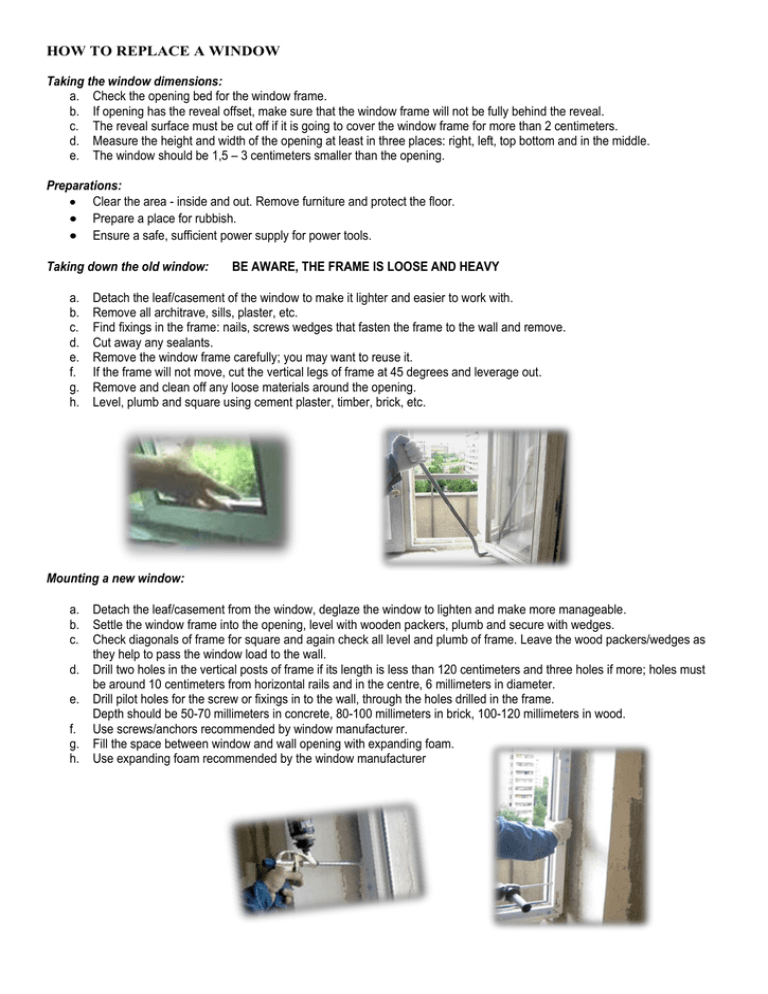HOW TO REPLACE A WINDOW
advertisement

HOW TO REPLACE A WINDOW Taking the window dimensions: a. Check the opening bed for the window frame. b. If opening has the reveal offset, make sure that the window frame will not be fully behind the reveal. c. The reveal surface must be cut off if it is going to cover the window frame for more than 2 centimeters. d. Measure the height and width of the opening at least in three places: right, left, top bottom and in the middle. e. The window should be 1,5 – 3 centimeters smaller than the opening. Preparations: Clear the area - inside and out. Remove furniture and protect the floor. Prepare a place for rubbish. Ensure a safe, sufficient power supply for power tools. Taking down the old window: a. b. c. d. e. f. g. h. BE AWARE, THE FRAME IS LOOSE AND HEAVY Detach the leaf/casement of the window to make it lighter and easier to work with. Remove all architrave, sills, plaster, etc. Find fixings in the frame: nails, screws wedges that fasten the frame to the wall and remove. Cut away any sealants. Remove the window frame carefully; you may want to reuse it. If the frame will not move, cut the vertical legs of frame at 45 degrees and leverage out. Remove and clean off any loose materials around the opening. Level, plumb and square using cement plaster, timber, brick, etc. Mounting a new window: a. Detach the leaf/casement from the window, deglaze the window to lighten and make more manageable. b. Settle the window frame into the opening, level with wooden packers, plumb and secure with wedges. c. Check diagonals of frame for square and again check all level and plumb of frame. Leave the wood packers/wedges as they help to pass the window load to the wall. d. Drill two holes in the vertical posts of frame if its length is less than 120 centimeters and three holes if more; holes must be around 10 centimeters from horizontal rails and in the centre, 6 millimeters in diameter. e. Drill pilot holes for the screw or fixings in to the wall, through the holes drilled in the frame. Depth should be 50-70 millimeters in concrete, 80-100 millimeters in brick, 100-120 millimeters in wood. f. Use screws/anchors recommended by window manufacturer. g. Fill the space between window and wall opening with expanding foam. h. Use expanding foam recommended by the window manufacturer Mounting new internal and external sills: a. Sills should be compatible and provided with the windows. The sill must be secured flush or inserted into the window frame. b. The sill should be cut to the shape of the reveal. The external sill must slope around 15 degrees away from the home. c. External sill should be UPVC, steel or ceramic tiles. The internal sill should be level: timber, ceramic tile or UPVC. d. Fill any voids/gaps below the sills with expanding foam. e. Trim back excess expanding foam with a knife. Finishing reveals/walls: a. External holes can be filled with expanding foam and sealed if a gap < 10 millimeters. External reveals can be made good with waterproof plaster, UPVC or timber. b. Internal reveals can be made good with plaster, UPVC or timber. c. Inside reveals can also be plastered with putty if no major damage. d. Seal all the joints with mastic. e. Apply two coats of facade paint or lime wash on plaster and/or timber. Finishing the work: a. b. c. d. e. Mount the glass pack back in the window frames, using supplied beads. Hang the window casement/leaf back on the hinges. Test manually how the window mechanically operates. Remove the manufacturer tapes on the frames and install other fixtures. Sign a formal act of work acceptance if you used a contractor.



